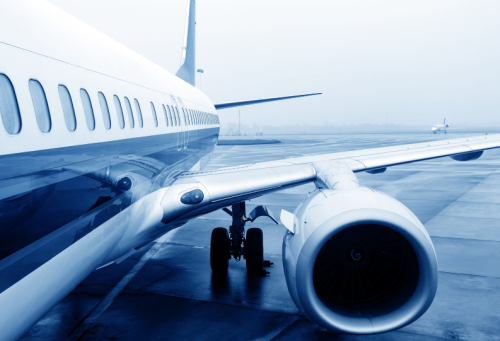
The global aviation industry is set for record revenues, passengers and expenses in 2024, underscoring a fragile profitability amidst ongoing political, economic, supply chain and geopolitical risks.
Strong air travel demand continues to drive revenue growth, modestly outpacing rising expenses. According to the International Air Transport Association (IATA), a record five billion air travellers are expected to travel in 2024, pushing industry revenues close to $1 trillion. In Europe, nearly all routes have surpassed pre-pandemic traffic levels and ticket sales are higher than last year, indicating rising air travel demand. However, the industry’s growth is capped by several external headwinds likely to slow momentum and pose risks to sustainable profitability.
Eclectic headwinds curb recovery celebrations
Airlines have shown resilience against inflation, high interest rates and slowing GDP growth in the post-pandemic period. Nevertheless, aircraft delivery bottlenecks, tight labour markets, and the rising costs of decarbonisation and climate change present significant challenges.
Ongoing threats to travel demand and operational freedom, such as frequent air traffic control strikes and geopolitical escalations, further cloud the sector’s optimism. Since 2023, there have been 84 days of French air traffic control strikes, forcing airlines to cancel thousands of EU overflights from Germany, Spain, Italy, Ireland and the UK, while French minimum service laws protect domestic French cancellations, according to Ryanair. Potential geopolitical escalations in the Russia–Ukraine and Israel–Hamas conflicts, adverse macroeconomic developments, and public policy shifts amid a historic year for elections, all further cloud the outlook for the aviation sector. Persistent supply chain and regulatory risks also exacerbate operational expenses, while airlines’ commendable commitment to achieving net-zero carbon emissions by 2050 entails significant costs and investment. Additionally, many airlines are still weighed down by pandemic-era debt, highlighting the fragile state of profitability.
Supply chain bottlenecks
Resolving supply chain and manufacturing issues is critical. Persistent supply chain challenges limit the maintenance of existing fleets and new aircraft deliveries, with a significant proportion of the global fleet still parked. According to IATA, 15% of major aircraft manufacturers’ fleets were in storage in 2023, compared to the 2000–2019 average of 10%. Specialised and regulated production chains prevent supplier diversification, and many suppliers operate below pre-pandemic levels. Skilled labour shortages and long lead times for critical components like engines and digital-equipped seats further constrain new aircraft deliveries and impact retrofitting, refurbishing and maintenance programmes.
Major aircraft manufacturers struggle
Boeing and Airbus face significant challenges in meeting new aircraft demand. Boeing delivered 24 new aircraft in May, including 19 of its 737 MAXs, compared to 50 planes delivered in May last year. Boeing’s delivery rate is notably below the production cap imposed by the Federal Aviation Administration (FAA) of 38 per month, following the blowout of an emergency door on a 737-9 MAX jet operated by Alaska Air. The FAA maintains oversight within Boeing’s factories and individually certifies newly produced aircraft.
Boeing reported orders of four new planes in May, compared to 69 orders in the same month last year, curbing airline growth potential and posing risks to Boeing’s credit rating. Fitch Ratings warned that continued weak aircraft deliveries, inventory liquidation, and a tepid recovery in its aircraft production rate could trigger a ratings downgrade over the coming 12 months, potentially reclassifying Boeing’s debt to junk status and increasing borrowing costs.
In the year to May, Boeing delivered 131 jets, compared to 206 over the same period last year. Airbus delivered 256 aircraft over the same period, up 5% from the 244 deliveries over the same period last year. In May, Airbus delivered 53 planes, more than twice Boeing’s 24, but still down from 63 a year ago. Airbus still needs to ramp up more to meet its annual target of 800 commercial aircraft deliveries. Globally, the number of aircraft deliveries scheduled for 2024 is expected to be 1,583, which is 11% less than the previous forecast of 1,777, according to IATA.
Operational and financial impacts
These bottlenecks pose substantial challenges for airline planning and operations, extending to financial performance. Delivery delays prevent airlines from maximising revenue growth, forcing them to deploy older planes for longer, risking more maintenance issues and delays. “Supply chain challenges are likely to be a feature for the industry for a couple of years to come – into 2025 and probably 2026”, Willie Walsh, IATA chief executive told Reuters.
Ryanair reported in May that it remains short of 23 Boeing 737 Max aircraft by the end of July, with CEO Michael O’Leary warning that “there remains a risk that Boeing deliveries could slip further”. O’Leary also said fares will be flat to modest ahead of last summer. Despite capacity constraints, fare pricing has not been as strong as anticipated, possibly due to consumer sentiment or recessionary concerns in Europe. Upcoming elections across Europe may also dampen consumers’ willingness to spend on travel, as economic uncertainties affect consumer sentiment. However, business class fares are expected to remain stable, with demand outstripping supply. In early June, airline CEOs gathered in Dubai for IATA’s annual meeting, where several chief executives singled out the UK for particularly weak demand. “In the UK, specifically in economy class, we’re seeing a bit less robust demand but a strong summer overall”, said Virgin Atlantic’s CEO Shai Weiss, according to Bloomberg reporting.
While the aviation industry is on track to achieve record revenues in 2024, significant challenges remain. These include supply chain disruptions, labour shortages, geopolitical risks, and the financial responsibilities that come with decarbonisation.
Daily News Round Up
Sign up to our daily news round up and get trending industry news delivered straight to your inbox
This site uses cookies to monitor site performance and provide a mode responsive and personalised experience. You must agree to our use of certain cookies. For more information on how we use and manage cookies, please read our Privacy Policy.